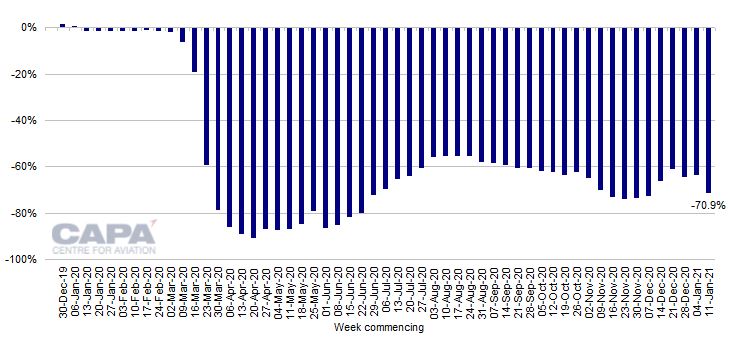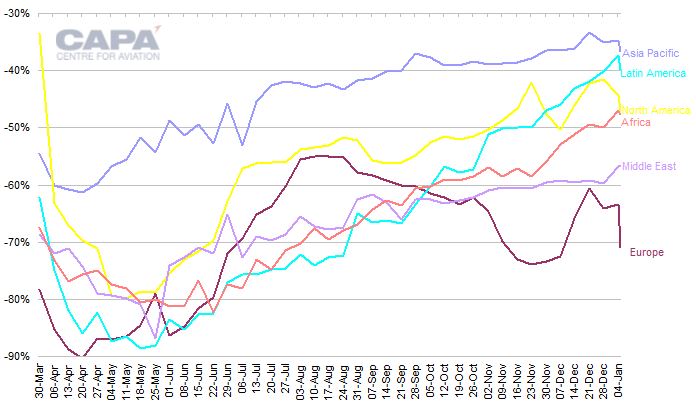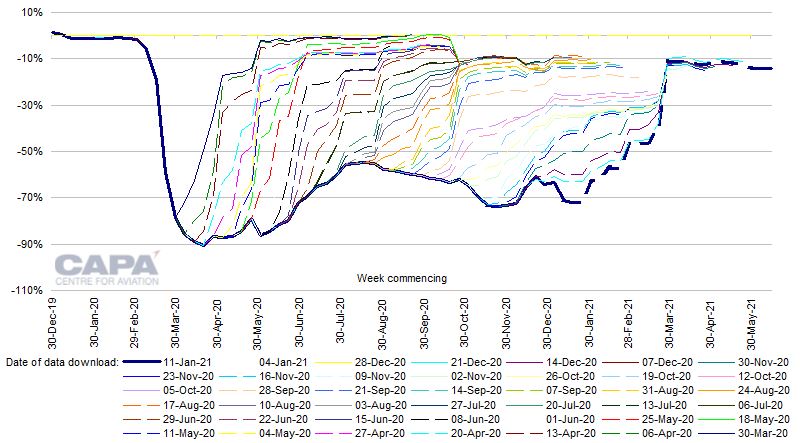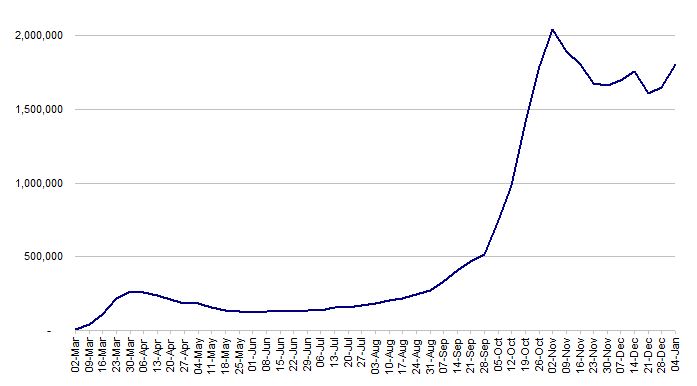Where travel agents earn, learn and save!
News / European airline capacity falls the most since first wave of COVID-19
Europe's airlines are operating 2.3 million fewer seats in the week of January 11, 2021

January 18 - Europe’s airlines are operating 2.3 million fewer seats in the week of January 11, 2021 compared with the previous week, which is a decline of 22.6%. This is the biggest week-on-week percentage fall since the first wave of the COVID-19 pandemic in June 2020.
Europe’s capacity this week is down by 70.9% from 2019 levels (the last full year before the crisis. This is easily the biggest fall of all world regions. Middle East capacity is down by 56.6%, Africa by 47.6%, North America by 46.9%, Latin America by 39.8%, and Asia Pacific by 36.7%.
For all regions, apart from the Middle East, these rates are worse than last week. COVID case numbers are rising again in Europe and in much of the rest of the world. Concerns over new strains of the virus are also increasing. Lockdown/travel restrictions have tightened and airlines are scaling back capacity plans.
Until vaccination programmes are more widely available and taken up (and shown to be effective), it seems likely that Europe’s airline capacity may slide further.
Europe has 7.8 million seats vs 26.8 million in 2019 – down 71%
In the week commencing January 11, 2021, total European seat capacity is scheduled to be 7.8 million, according to schedules from OAG combined with CAPA Fleet Database seat configurations.
This is 70.9% below the 26.8 million seats of the equivalent week of 2019. This is also 7.5ppts worse than the previous week’s 63.4% drop, the biggest percentage fall in six weeks, and the 43rd week of very heavy double digit percentage (more than 50%) declines in seats versus 2019.
This week’s total seat capacity for Europe is split between 4.0 million domestic seats, versus 7.2 million in the equivalent week of 2019; and 6.0 million international seats, versus 20.3 million.
Europe’s domestic seats have been cut by 54.2% versus 2019, compared with last week’s -44.3%. Week-on-week, 725,000 domestic seats have been removed from the market.
International seat capacity is down by 77.1% versus 2019, compared with last week’s -70.2%. Week-on-week, 1.54 million international seats have been removed.
Europe: percentage change in weekly airline seat capacity vs equivalent week of 2019, December 30, 2019 to January 11, 2021

Europe has spent 12 weeks in last place behind the other regions
When ranked by the decline in weekly seat numbers, Europe has now spent 12 weeks at the bottom of the regional league table, compared with the equivalent week of 2019.
Its 70.9% cut in seat numbers compared with 2019 is 14.3ppts worse than the next deepest, the Middle East, which is down by 56.6% this week.
Africa’s seat count is down by 47.6%, North America’s by 46.9%, Latin America’s by 39.8% and Asia Pacific’s by 36.7%.
Asia Pacific has now had 27 consecutive weeks at more than 50% of last year’s capacity. North America has now been above this threshold for 10 weeks, and Latin America has now had nine weeks at or above 50% of 2019 levels.
Only Europe and the Middle East have yet to reach the 50% threshold.
Percentage change in passenger seat capacity vs 2019 by region: week of March 30, 2020 to week of January 11, 2021

Jan-2021 capacity now projected at 30% of 2019 levels, vs 32% in December 2020
After the capacity recovery reached 45% of 2019 levels in August 2020, it slid back to 41% in September 2020, 38% in October 2020 and just 30% in November 2020. December 2020 stabilized the trend, with seats at 32% of 2019 levels.
However, as predicted by CAPA, the trend is now falling again. See related report: Europe aviation: 2020 hindsight and 2021 vision
Projected capacity in Europe derived from OAG schedules for next week (commencing January 18, 2021) is 72.1% below 2019 levels. This is worse than this week’s 70.9% decline and a rare example of schedules falling in the first week into the future.
Projected capacity for all of January 2021 has been cut by 6% compared with last week and is now projected to be at 30% of January 2019 seat numbers.
February 2021 capacity has been cut by 5% since last week and is now projected to be at 40% of 2019 levels. March 2021 is projected at 55% of 2019 capacity.
Europe: percentage change in airline seat capacity vs equivalent week of 2019, with outlook at different dates*

COVID-19 case numbers in Europe are rising again
Weekly COVID-19 case numbers in Europe reported to the World Health Organization have been rising once more.
After falling from a peak of 2.04 million cases in the week of November 2, 2020, to 1.61 million in the week of December 21, 2020, Europe has recorded a 12% increase over the past two weeks, to 1.80 million in the week of January 4, 2021.
In the UK alone, case numbers increased by 68%, from 249,000 to 418,000, over the same two-week period, as a new strain of the virus there spread more rapidly.
Much of the rest of the world has also experienced rising weekly case numbers in the past week.
Europe: weekly numbers of confirmed cases of COVID-19, March 2, 2020 to January 4, 2021

Airlines are scaling back capacity plans
The return of lockdown-like restrictions across much of Europe, particularly the UK, and a ban on arrivals from the UK by many countries, have caused airlines to scale back previous capacity plans.
Ryanair, Europe’s largest airline by annual passenger numbers and one of its more opportunistic operators, expects its January 2021 traffic to be less than 1.25 million – this is an 88% reduction year-on-year (after an 82% reduction in December 2020).
Ryanair expects “few, if any, flights being operated to/from Ireland or the UK” from the end of January 2021. The ultra LCC said new coronavirus restrictions could also reduce February 2020 and March 2020 traffic to approximately 500,000 passengers per month.
For the year to March 2021, Ryanair has lowered its traffic guidance from its previous forecast of less than 35 million to a range of 26 million to 30 million passengers. This compares with 148.6 million passengers carried in the year to March 2020.
However, it does not expect the service cuts and traffic reductions to affect its net loss materially for FY2021.
The current 71% capacity reduction is unlikely to be the low water mark
At present, the positive impact of vaccination programmes on demand for air travel in Europe, and some relaxation of quarantines (such as the UK cutting the quarantine period from 14 to 10 days, or five days with a negative COVID test on day five), is more than offset by the negative impact of national lockdowns and new restrictions on international travel.
Tipping the balance back to a more favourable scenario for aviation will depend on vaccination programmes: the pace and effectiveness of manufacture and distribution, uptake in the community, and the efficacy of vaccinations against existing and new strains of the virus.
These factors cannot be controlled by airline executives. As a result, demand will remain highly uncertain at least for the rest of winter 2020/2021. Airlines will continue to focus on conserving cash, only operating flights if cash income is likely to exceed the incremental cash costs of operating.
This week’s 71% reduction in seat capacity from 2019 levels looks unlikely to be the low water mark in the current ebb tide of European aviation.
More Travel News:
AMResorts shares CleanComplete+ Updates on COVID-19
Statement on closure of UK travel corridors
Madrid set to host key week for Global Tourism
Luxury Experiences Safely Redesigned for Fun & Relaxation











